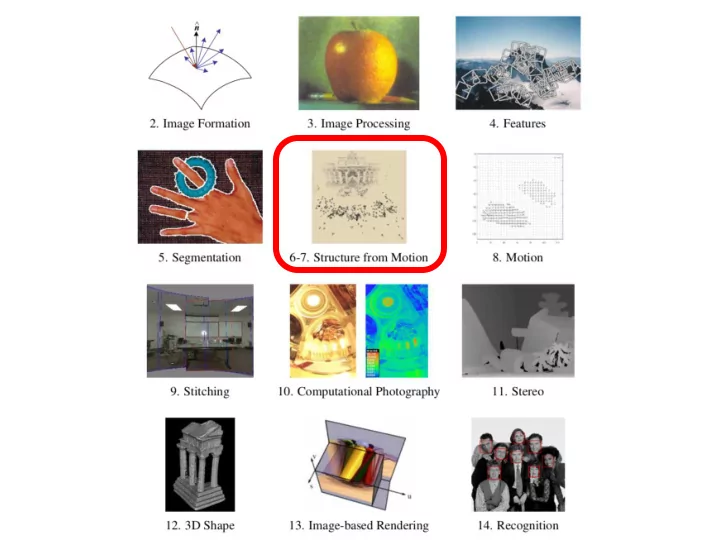

Frank Dellaert Fall 2019
Feature-based Image Alignment • Geometric image registration – 2D or 3D transforms between them – Special cases: pose estimation, calibration Image credit Szeliski book Frank Dellaert Fall 2019
2D Alignment • 3 photos • Translational model Image credit Szeliski book Frank Dellaert Fall 2019
2D Alignment • Input: – A set of matches {(x i , x i ’)} – A parametric model f(x; p) • Output: – Best model p* • How? Image credit Szeliski book Frank Dellaert Fall 2019
2D translation estimation • Input: – Set of matches {(x 1 , x 1 ’), (x 2 , x 2 ’), (x 3 , x 3 ’), (x 4 , x 4 ’)} – Parametric model: f(x; t) = x + t – Parameters p == t, location of origin of A in B • Output: – Best model p* Image credit Szeliski book Frank Dellaert Fall 2019
2D translation estimation • Input: – Set of matches {(x 1 , x 1 ’), (x 2 , x 2 ’), (x 3 , x 3 ’), (x 4 , x 4 ’)} – Parametric model: f(x; t) = x + t – Parameters p == t, location of origin of A in B • Question for class: – What is your best guess for model p* ?? Image credit Szeliski book Frank Dellaert Fall 2019
2D translation estimation [-550, -100] • How? – One correspondence x1 = [600, 150], x1’ = [50, 50] – Parametric model: x’ = f(x; t) = x + t => t = x’- x => t = [50-600, 40-150] = [-550, -100] Image credit Szeliski book Frank Dellaert Fall 2019
2D translation via least-squares • How? – A set of matches {(x i , x i ’)} – Parametric model: f(x; t) = x + t – Minimize sum of squared residuals: Image credit Szeliski book Frank Dellaert Fall 2019
How to solve? Jacobian Normal equations Hessian Frank Dellaert Fall 2019
Linear models menagerie • All the simple 2D models are linear! • Exception: perspective transform Figure credit Szeliski book Frank Dellaert Fall 2019
2D translation via least-squares Image credit Szeliski book Frank Dellaert Fall 2019
Oops I lied !!! Euclidean is not linear! • All the simple 2D models are linear! • Euclidean Jacobians are a function of θ! Figure credit Szeliski book Frank Dellaert Fall 2019
Nonlinear Least Squares Frank Dellaert Fall 2019
Projective/H • Jacobians a bit harder Image credit Graphics Mill • Parameterization: (educational Use) • x’= f(x,p): • And Jacobian: Frank Dellaert Fall 2019
Closed Form H • Taking x’=f(x,p): Image credit Graphics Mill (educational Use) • Divide both sides by : • 4 matches => system of 8 linear equations Frank Dellaert Fall 2019
RANSAC
Motivation • Estimating motion models • Typically: points in two images • Candidates: – Translation – Homography – Fundamental matrix Frank Dellaert Fall 2019
Mosaicking: Homography www.cs.cmu.edu/~dellaert/mosaicking Frank Dellaert Fall 2019
Two-view geometry (next lecture) Frank Dellaert Fall 2019
Omnidirectional example Images by Branislav Micusik, Tomas Pajdla, cmp.felk.cvut.cz/ demos/Fishepip/ Frank Dellaert Fall 2019
Simpler Example • Fitting a straight line Frank Dellaert Fall 2019
Discard Outliers • No point with d>t • RANSAC: – RANdom SAmple Consensus – Fischler & Bolles 1981 – Copes with a large proportion of outliers Image credit Choi et al BMVC 2009 Frank Dellaert Fall 2019
Main Idea • Select 2 points at random • Fit a line • “Support” = number of inliers • Line with most inliers wins Image credit shutterstock, academic use Frank Dellaert Fall 2019
Why will this work ? Frank Dellaert Fall 2019
Best Line has most support • More support -> better fit Image credit Wikipedia Frank Dellaert Fall 2019
In General • Fit a more general model • Sample = minimal subset – Translation ? – Homography ? – Euclidean transorm ? Frank Dellaert Fall 2019
RANSAC • Objective: – Robust fit of a model to data D • Algorithm – Randomly select s points – Instantiate a model – Get consensus set D i – If |D i |>T, terminate and return model – Repeat for N trials, return model with max |D i | Image credit Wikipedia Frank Dellaert Fall 2019
Distance Threshold • Requires noise distribution • Gaussian noise with s • Chi-squared distribution with DOF m – 95% cumulative: – Line, F: m=1, t=3.84 s 2 – Translation, homography: m=2, t=5.99\ s 2 • I.e. -> 95% prob that d<t is inlier Image credit Wikipedia Frank Dellaert Fall 2019
How many samples ? • We want: at least one sample with all inliers • Can’t guarantee: probability P • E.g. P = 0.99 Image credit Wikipedia Frank Dellaert Fall 2019
Calculate N • If etha = outlier probability • proportion of inliers p = 1-etha • P(sample with all inliers) = p s • P(sample with an outlier) = 1-p s • P(N samples an outlier) = (1-p s )^N • We want P(N samples an outlier) < 1-P e.g. 0.01 • (1-p s )^N < 1-P • N > log(1-P)/log(1-p s ) Image credit Wikipedia Frank Dellaert Fall 2019
Example • P=0.99 • s=2, etha=5% => N=2 • s=2, etha=50% => N=17 • s=4, etha=5% => N=3 • s=4, etha=50% => N=72 • s=8, etha=5% => N=5 • s=8, etha=50% => N=1177 Image credit Wikipedia Frank Dellaert Fall 2019
Remarks • N = f(etha), not the number of points • N increases steeply with s Image credit Wikipedia Frank Dellaert Fall 2019
Threshold T • Terminate if |D i |>T • Rule of thumb: T » #inliers • So, T = (1-etha)n = pn Image credit Wikipedia Frank Dellaert Fall 2019
Adaptive N • When etha is unknown ? • Start with etha = 50%, N=inf • Repeat: – Sample s, fit model – -> update etha as |outliers|/n – -> set N=f(etha, s, p) • Terminate when N samples seen Image credit Wikipedia Frank Dellaert Fall 2019
Recommend
More recommend